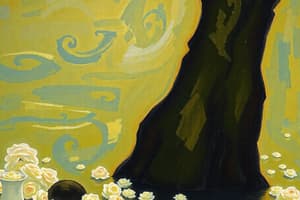Podcast
Questions and Answers
Which statement accurately describes the alkali metals?
Which statement accurately describes the alkali metals?
- They are generally hard metals with high melting points.
- They react vigorously with acids but not with water.
- They lose one electron to form +1 cations. (correct)
- They readily gain one electron to form -1 anions.
What is a common oxidation state for elements in the boron group?
What is a common oxidation state for elements in the boron group?
- +3 (correct)
- +4
- +1
- +2
Which group of elements is known for forming covalent compounds, particularly hydrides and halides?
Which group of elements is known for forming covalent compounds, particularly hydrides and halides?
- Group 13 (correct)
- Group 1
- Group 2
- Group 15
Which group contains elements that typically react with water, albeit less vigorously than alkali metals?
Which group contains elements that typically react with water, albeit less vigorously than alkali metals?
Which of the following correctly identifies an essential component of proteins and nucleic acids?
Which of the following correctly identifies an essential component of proteins and nucleic acids?
What characterizes the elements in Group 16?
What characterizes the elements in Group 16?
Which element is classified as a metalloid in the boron group?
Which element is classified as a metalloid in the boron group?
Which set of elements typically forms ionic compounds with nonmetals?
Which set of elements typically forms ionic compounds with nonmetals?
Flashcards
Representative elements
Representative elements
Elements in groups 1, 2, and 13-18 of the periodic table.
Alkali Metals (Group 1)
Alkali Metals (Group 1)
Elements that readily lose one electron to form +1 ions, highly reactive with water.
Alkaline Earth Metals (Group 2)
Alkaline Earth Metals (Group 2)
Elements that readily lose two electrons to form +2 ions, less reactive than alkali metals.
Group 17 (Halogens)
Group 17 (Halogens)
Signup and view all the flashcards
Oxidation State
Oxidation State
Signup and view all the flashcards
Ionic Bonding
Ionic Bonding
Signup and view all the flashcards
Covalent Bonding
Covalent Bonding
Signup and view all the flashcards
Metallic Bonding
Metallic Bonding
Signup and view all the flashcards
Study Notes
Representative Inorganic Compounds
- Representative elements, often called main group elements, are those found in groups 1, 2, and 13-18 of the periodic table.
- Their chemistry is characterized by the formation of ions with common oxidation states.
- These compounds often exhibit diverse bonding types, including ionic bonding, covalent bonding and metallic bonding.
Group 1 (Alkali Metals)
- These elements readily lose one electron to form +1 cations (e.g., Na+, K+).
- They typically react vigorously with water to produce hydrogen gas and hydroxide ions.
- They form ionic compounds with nonmetals, exhibiting high reactivity.
- They are soft, silvery-white metals.
Group 2 (Alkaline Earth Metals)
- These elements readily lose two electrons to form +2 cations (e.g., Mg2+, Ca2+).
- They are less reactive than alkali metals but still react with water.
- They form ionic compounds with nonmetals, particularly halides.
- They are harder and have higher melting points than alkali metals.
Group 13 (Boron Group)
- Elements in this group exhibit a variable oxidation state, often +3 (e.g., Al3+, Ga3+).
- Boron (B) is a metalloid, while the others are metals.
- They are known for forming covalent compounds, particularly hydrides and halides.
- Aluminum (Al) is extremely important due to its abundance and use in various applications
Group 14 (Carbon Group)
- Elements of this group display a wide range of bonding types, including covalent, metallic, and ionic.
- Carbon (C) forms an extraordinary diversity of organic and inorganic compounds.
- The Group 14 elements show a range of oxidation states, with +4 being common.
Group 15 (Nitrogen Group)
- These elements exhibit various oxidation states, ranging from -3 to +5.
- The chemistry of nitrogen is largely dominated by covalent bonding.
- They are essential elements in biological systems, particularly nitrogen as a component of proteins and nucleic acids.
Group 16 (Oxygen Group)
- These elements exhibit a wide range of oxidation states, primarily from -2 to +6.
- Oxygen (O) is vital for life and forms oxides with most elements.
- Sulphur (S) is important industrially, forming numerous compounds.
Group 17 (Halogens)
- Halogens are highly reactive nonmetals that readily gain one electron to form -1 anions (e.g., Cl-, Br-).
- They exist as diatomic molecules and are good oxidizing agents.
- They form ionic compounds with metals and covalent compounds with other nonmetals.
Group 18 (Noble Gases)
- These elements are generally unreactive due to their stable electron configurations.
- They exhibit very limited chemical reactivity.
- They form compounds (albeit rarely) under specific conditions.
General Trends in Representative Elements
- Reactivity generally decreases across a period from left to right, and increases down a group.
- Metallic character increases down a group and decreases across a period.
- Oxidation states are often related to the number of valence electrons in the element.
- Bonding properties like ionic and covalent are often determined by electronegativity differences between the elements involved.
Studying That Suits You
Use AI to generate personalized quizzes and flashcards to suit your learning preferences.




